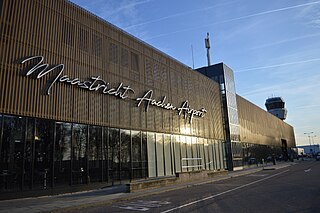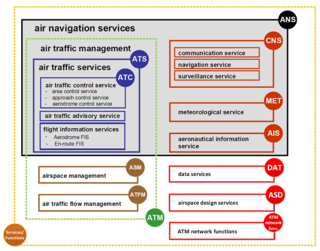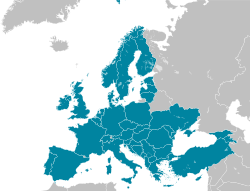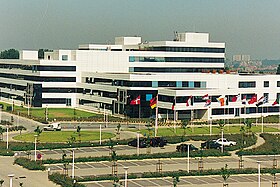The Single European Sky (SES) is a European Commission initiative that seeks to reform the European air traffic management system through a series of actions carried out in four different levels with the aim of satisfying the needs of the European airspace in terms of capacity, safety, efficiency and environmental impact.

Air traffic control (ATC) is a service provided by ground-based air traffic controllers who direct aircraft on the ground and through a given section of controlled airspace, and can provide advisory services to aircraft in non-controlled airspace. The primary purpose of ATC worldwide is to prevent collisions, organize and expedite the flow of air traffic, and provide information and other support for pilots.
NATS Holdings, formerly National Air Traffic Services and commonly referred to as NATS, provides en-route air traffic control services to flights within the UK flight information regions and the Shanwick Oceanic Control Area. It also provides air traffic control services to 14 UK airports.

The Irish Aviation Authority (IAA) is a commercial semi-state company in Ireland responsible for the regulation of safety aspects of air travel. Its head office is in The Times Building in Dublin.

Maastricht Aachen Airport is a major cargo hub and regional passenger airport in Beek in Limburg, Netherlands, located 5 NM northeast of Maastricht and 15 NM northwest of Aachen, Germany. It is the second-largest hub for cargo flights in the Netherlands. As of 2022, the airport had a passenger throughput of 266,000 and handled 108,000 tons of cargo.

ENAIRE is the air navigation manager in Spain, certified for the provision of enroute, approach and aerodrome control services. As a public corporate entity attached to the Spanish Ministry of Public Works, it is responsible for air traffic control, aeronautical information and the communication, navigation and surveillance networks so air companies and their aircraft can fly safely and in an organised format within Spanish airspace.

Air traffic management (ATM) aims at ensuring the safe and efficient flow of air traffic. It encompasses three types of services:

Airservices Australia is an Australian Government-owned corporation, responsible for providing services to the aviation industry within the Australian Flight Information Region (FIR). Some of Airservices Australia’s responsibilities include air traffic control, airway navigation, communication facilities, publishing aeronautical data, airport rescue, and fire-fighting services. Airservices Australia has international partnerships with ICAO, CANSO and IATA.
Air traffic control in Australia is provided by two independent organisations, one civilian and one military. The civilian provider is Airservices Australia, which controls civilian airfields and airspace. The military provider is the Royal Australian Air Force (RAAF), which controls military airfields and adjoining airspace. This includes Australian Army and Royal Australian Navy aviation bases.
Skyguide is an air navigation service provider which manages and monitors Swiss airspace. The company, which was formerly known as Swisscontrol, changed its name to skyguide in 2001. Skyguide is a joint-stock company under Swiss private law which is responsible, on behalf of the Swiss Confederation, for ensuring the safety of all Swiss airspace and of adjoining airspace areas in Germany, Austria, France and Italy that have been delegated to its control. For Swiss airspace, this duty extends to both civil and military air navigation services.
System Wide Information Management (SWIM) is a global Air Traffic Management (ATM) industry initiative to harmonize the exchange of Aeronautical, Weather and Flight information for all Airspace Users and Stakeholders. SWIM is an integral part of the International Civil Aviation Organization (ICAO) Global Air Navigation Plan (GANP). The GANP defines 4 Performance Improvement Areas (PIA), SWIM resides in PIA 2: Globally interoperable systems and data, where its implementation is further defined in Aviation System Block Upgrades (ASBU) B1-SWIM and B2-SWIM. ASBU B1-SWIM defines SWIM as a “a net-centric operation where the air traffic management (ATM) network is considered as a series of nodes, including the aircraft, providing or using information.” it goes on to say “The sharing of information of the required quality and timeliness in a secure environment is an essential enabler to the ATM target concept.”
Controller–pilot data link communications (CPDLC), also referred to as controller pilot data link (CPDL), is a method by which air traffic controllers can communicate with pilots over a datalink system.
The First European Air Traffic Controller Selection Test (FEAST) is a tool that helps Air Navigation Service Providers (ANSPs) identify the most suitable candidates for the job of air traffic controllers. FEAST was designed by and made available by (EUROCONTROL), the European Organisation for the Safety of Air Navigation. It is used by 44 organisations, including civil and military European Air Navigation Service Providers and certified ATC aviation training academies and universities.
In aviation, an air traffic service (ATS) is a service which regulates and assists aircraft in real-time to ensure their safe operations. In particular, ATS is to:
Single European Sky ATM Research (SESAR) is a collaborative project to completely overhaul European airspace and its air traffic management (ATM). The actual program is managed by the SESAR Joint Undertaking as a public–private partnership (PPP).

RMCDE is the name of a system designed to distribute the surveillance information to a community of user systems.

CIMACT is EUROCONTROL's Civil-Military Air Traffic Management Co-ordination Tool.
BULATSA is the Bulgarian Air Traffic Services Authority, a branch of the Bulgarian Civil Aviation Administration responsible for air traffic management within Bulgaria's airspace.
Skeyes, formerly called Belgocontrol or in its complete form the Authority of airways, is the Belgian air navigation and traffic service provider for the civil airspace for which the Belgian State is responsible. It was created in 1998.

Estonian Air Navigation Services, abbreviated as EANS, is a modern, rapidly developing company operating under the auspices of the Ministry of Economic Affairs and Communications of the Republic of Estonia. It is a business entity, the major function of which is to provide services to air traffic in accordance with international standards as well as to ensure flight safety in Tallinn Flight Information Region. The sole owner of the company shares is the Republic of Estonia.













